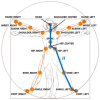Fall risk assessment and early-warning for toddler behaviors at home
- PMID: 24335727
- PMCID: PMC3892873
- DOI: 10.3390/s131216985
Fall risk assessment and early-warning for toddler behaviors at home
Abstract
Accidental falls are the major cause of serious injuries in toddlers, with most of these falls happening at home. Instead of providing immediate fall detection based on short-term observations, this paper proposes an early-warning childcare system to monitor fall-prone behaviors of toddlers at home. Using 3D human skeleton tracking and floor plane detection based on depth images captured by a Kinect system, eight fall-prone behavioral modules of toddlers are developed and organized according to four essential criteria: posture, motion, balance, and altitude. The final fall risk assessment is generated by a multi-modal fusion using either a weighted mean thresholding or a support vector machine (SVM) classification. Optimizations are performed to determine local parameter in each module and global parameters of the multi-modal fusion. Experimental results show that the proposed system can assess fall risks and trigger alarms with an accuracy rate of 92% at a speed of 20 frames per second.
Figures












Similar articles
-
Continuous detection of human fall using multimodal features from Kinect sensors in scalable environment.Comput Methods Programs Biomed. 2017 Jul;146:151-165. doi: 10.1016/j.cmpb.2017.05.007. Epub 2017 May 25. Comput Methods Programs Biomed. 2017. PMID: 28688485
-
Identifying Fall Risk Predictors by Monitoring Daily Activities at Home Using a Depth Sensor Coupled to Machine Learning Algorithms.Sensors (Basel). 2021 Mar 11;21(6):1957. doi: 10.3390/s21061957. Sensors (Basel). 2021. PMID: 33799526 Free PMC article.
-
Quantitative falls risk estimation through multi-sensor assessment of standing balance.Physiol Meas. 2012 Dec;33(12):2049-63. doi: 10.1088/0967-3334/33/12/2049. Epub 2012 Nov 15. Physiol Meas. 2012. PMID: 23151494
-
Using dynamic walking models to identify factors that contribute to increased risk of falling in older adults.Hum Mov Sci. 2013 Oct;32(5):984-96. doi: 10.1016/j.humov.2013.07.001. Epub 2013 Oct 10. Hum Mov Sci. 2013. PMID: 24120280 Free PMC article. Review.
-
Review of fall risk assessment in geriatric populations using inertial sensors.J Neuroeng Rehabil. 2013 Aug 8;10(1):91. doi: 10.1186/1743-0003-10-91. J Neuroeng Rehabil. 2013. PMID: 23927446 Free PMC article. Review.
Cited by
-
Relationship between overweight/obesity in the first year of age and traumatic dental injuries in early childhood: Findings from a birth cohort study.Dent Traumatol. 2017 Dec;33(6):465-471. doi: 10.1111/edt.12377. Dent Traumatol. 2017. PMID: 28965356 Free PMC article.
-
Statistical analysis-based error models for the Microsoft Kinect(TM) depth sensor.Sensors (Basel). 2014 Sep 18;14(9):17430-50. doi: 10.3390/s140917430. Sensors (Basel). 2014. PMID: 25237896 Free PMC article.
-
Appearance-based multimodal human tracking and identification for healthcare in the digital home.Sensors (Basel). 2014 Aug 5;14(8):14253-77. doi: 10.3390/s140814253. Sensors (Basel). 2014. PMID: 25098207 Free PMC article.
References
-
- Morrongiello B., Ondejko L., Littlejohn A. Understanding toddlers' in-home injuries: I. Context, correlates, and determinants. J. Pediatr. Psychol. 2004;29:415–431. - PubMed
-
- Purwar A., Jeong D., Chung W. Activity Monitoring from Real-Time Triaxial Accelerometer Data Using Sensor Network. Proceedings of the IEEE International Conference on Control, Automation and Systems; Seoul, Korea. 17–20 October 2007; pp. 2402–2407.
-
- Bourke A., Lyons G. A threshold-based fall-detection algorithm using a bi-axial gyroscope sensor. Med. Eng. Phys. 2008;30:84–90. - PubMed
-
- Sixsmith A., Johnson N. A smart sensor to detect the falls of the elderly. IEEE Pervasive Comput. 2004;3:42–47.
Publication types
MeSH terms
LinkOut - more resources
Full Text Sources
Other Literature Sources
Medical

